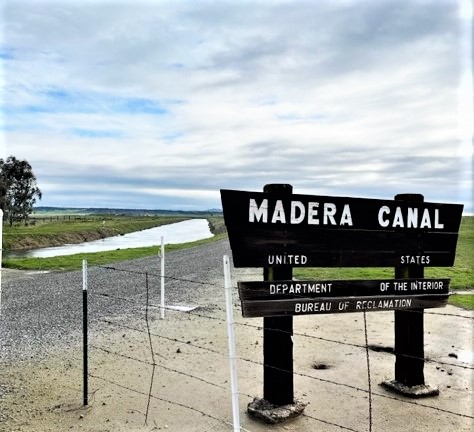The Madera County board of supervisors held its regular meeting on January 10, 2023. Longtime and reelected Supervisor David Rogers is the new chair. Elected to the board are two new supervisors – Jordan Wamhoff, District 1 and Robert Macaulay, District 5. After doing other business, the supervisors convened as the GSA board at 11:12 a.m. There were two items on the agenda affecting white area growers… lowering water allocations and raising penalties for exceeding them. After board discussion and considerable public comment, at the end of the meeting both allocations and penalties remained in place.
However, at the meeting to be held January 24, higher penalties will be considered, and it is expected that a resolution for action will be presented. There was also broad agreement that the DWR should be petitioned to allow landowners immediate access to flood flows, as water rights allow, in order to recharge as much as possible during this wet season, with a credit given for use in 2023.
Here’s How it Went
Leading off with a presentation, Stephanie Anagnoson, Director of Water and Natural Resources for the county, tipped her hand. She said the staff recommendation was that allocations should remain in place. She said that good water resources planning is a slow and steady process, and the allocations will be reviewed on schedule in 2025. This was in spite of material in the agenda that justified lowering allocations, pointing out that with no 218 funding, halted by a temporary court injunction, there would be no projects to improve groundwater recharge as described in the GSP. In her presentation, she once again restated the large of amount of planning, public communication and board consideration that had occurred since 2017. She referenced a letter received from the Madera Irrigation District that suggested the GSP might need to be adjusted as a result of the injunction. But she maintained that growers have asked for consistency in the regulations. She said there is no timeline that requires an immediate change and therefore allocations should be considered in 2025 as scheduled.
restated the large of amount of planning, public communication and board consideration that had occurred since 2017. She referenced a letter received from the Madera Irrigation District that suggested the GSP might need to be adjusted as a result of the injunction. But she maintained that growers have asked for consistency in the regulations. She said there is no timeline that requires an immediate change and therefore allocations should be considered in 2025 as scheduled.
Director Anagnoson also presented a draft temporary emergency recharge policy that would apply to landowners who voluntarily initiated surface water recharge. She referred to a handout available which says that the County GSA intends to recognize an approximate recharge credit for such water that could be applied to the 2023 allocation. The document outlines landowner responsibilities which include documentation of legal access and other specific arrangements. The credit is intended to be used for agricultural irrigation this year. There was strong consensus in the room among supervisors and the public alike that this approach is desirable and that given weather and water conditions, time is of the essence. After comments from the supervisors, she said that a resolution for approval would be available for the January 24 meeting.
Chairman Rogers reacted to the MID letter referenced by the Director. He said that local farming is a beautiful thing and food production is a national security issue. He said it is state policies that are responsible for the decline of water availability… “they created this mess.” He continued saying that back-ups at the sea ports are preventing farmers from exporting, further reducing their prices. He said we must do more than cast blame, though. We are suffering, he said, but “action is a must.” He said aggressive recharge is key and that even though the GSA fees are on hold, MID and Chowchilla Water District are doing it along with individual farmers. He said that farming will continue through groundwater recharge, and he cited as an example the work of dairy farmer Larry Pietrowski who, he says, has an interconnected network of basins that allow water to be moved around his property. He continued saying that while the matter is in the courts, we should stay the course on allocations. He said crop prices on their own will reduce demand for water. He said, “We are in a five-year plan, not a one-year plan and that MID can gripe all they want.”
With that, Supervisor Letitia Gonzales invited public comment. Leading off was well-known Madera grower Kevin Herman who said he was there to encourage the board to stay the course on allocations. He said that MID can move water to white areas but is charging $200 per acre/foot. He said he farms trees, and has pulled out old orchards, has young orchards, young trees and vacant land. He said we have to have some consistency. “Don’t make any changes in allocations,” he said.
Local grower Mark Peters thanked Herman and staff saying that like many farmers he was taking steps to that will “dramatically reduce demand.” He said he wonders where the GSA has come out on water use overall compared to the allocation. He said don’t make changes after harvest because farmers are already spending money for the next crop year, pruning, spraying, contracting for bees and more. This is money already spent.
Karun Samran introduced himself as one of five board members of the Chowchilla Subbasin Growers group. He said he wanted to keep the supervisors up to date on progress towards creating a public service entity to fund the GSP in light of the fact that the 218 fees were voted down. He said that of the 38,819 acres in the GSA, 91 percent had been enrolled with CSG. He said $580,000 has been collected to cover the estimated costs of the domestic well mitigation program. He said their efforts are supported by the Chowchilla and the Triangle T Water Districts. The supervisors expressed their continuing support for this local effort. (Note: On January 11, the Chowchilla Water District acted to create a checking account to hold and disburse these funds.)
Speaking next, Brad Samuelson, a water consultant advising the CSG, said farmers there are implementing projects even though fees are not being collected. He too advocated that allocations remain the same.
Identifying herself as farming 27 acres in Madera County, Janice Gomes welcomed the new board members and asked that the allocation remain the same. She said when the lawsuit is settled, she may still have to pay her assessment of $4000 “which I don’t have.” She appreciated the refund on her December taxes, too.
In terms of capturing flood flows, dairy farmer Larry Pietrowski next at the podium said that first you must be able to legally secure the water. Then the permit costs $6000 to $8000 and will take six months. He asked the board to petition the governor, recruiting all the other GSAs for a temporary, emergency permit.
Devin Aviles, representing a growers’ cooperative, said he supported the staff recommendation of no change in the allocations. He also asked what the impact will be on domestic well mitigation funding [in the Madera Subbasin as a result of the injunction on collecting fees.]
Madera farmer Bill Dietrich pointed out that another item on the board agenda was approval of a letter to a state agency objecting to adding certain insects to the endangered species list. He supported the board’s position and encouraged that type of comment to state agencies. He said he’s grateful that ponding basins are exempt from the endangered species act, calling it the “stadium act” because new football stadiums are exempt. He said he did not begrudge the MID for charging $200 per acre/foot for water sold outside the District. He said District landowners for years have paid for the costs of the infrastructure that allow surface water to be purchased and made available. He said we also have to be careful what we say about water rights. When San Joaquin River water is brought into the San Luis Reservoir, it allows the Exchange Contractors to obtain their allocations which reduces the demand on Friant water.
Local grower and activist Ralph Pistoresi welcomed the new board members and agreed with Chairman Rogers’ earlier statement about the state’s problem. He said there should be a countywide provision that if flood waters are moving through, farmers should immediately take advantage of them. The county needs to go to the State Water Board and there needs to be a conditional use permit for the flood waters that are flowing.
immediately take advantage of them. The county needs to go to the State Water Board and there needs to be a conditional use permit for the flood waters that are flowing.
Representing the grower group bringing suit against the 218 fees, Mark Takata said he had sent another letter to the supervisors which he did not deliver in time to have it put in their packets. He said he had written to all the water districts asking them to join in requesting the governor to release flows into the California Aqueduct. He said the governor has this authority. He said he asks the county to help farmers and GSAs come together to take advantage of these flood flows. Rancher and farmer Michelle Lascoigty said that some four miles of her white area property is adjacent to surface water. She encouraged that grasslands be included in the emergency provision allowing capture of flood flows.
Speaking online, Jack Rice of the Madera Ag Water Association of farmers in the white areas said he appreciated the recommendation [of no allocation change] that everyone was agreeing on. Consistency is needed, he said, and he supported the staff recommendation. He said he agreed with Dietrich’s comments about water rights and unintended consequences.
With no further public comment, Director Anagnoson took the podium once again. She said there have been a number of people asking for a change in allocations, either up or down, but she recommends no change and that no action is needed. She invited a board member and a farmer to go with her to Sacramento to meet with DWR about an emergency policy on flood flow capture. She said the emergency policy will be brought back to the board for action. County Administrator Jay Varney wanted to confirm for the record that credit would be available back to January 1 if an emergency provision took affect sometime later. Confirmed! Supervisor Gonzalez asked if a special meeting of the GSA might be held to consider an emergency measure. Supervisor Wamhoff agreed that it was “a crime” that this water can’t go into the ground. The flood flows belong to the people, he said.
The meeting then focused on the question of adjusting the penalties for those landowners who exceed their water allocations. Director Anagnoson had several slides which shows that most people (some 70 percent) have lived within their allocations. There is also a group that has gone over by ten percent or less, and these were characterized as “trying.” Later in the discussion, she noted that nine farm units had exceeded their allocation by 50 percent or more. She said all the landowners in the GSA would receive a report showing what their water use was.
She suggested to the supervisors that they might want to modify the penalty. She said when the $100 per acre/foot was established, it was anticipated that there would also be a per acre charge of $246. With that charge no longer imposed, she said many regarded the $100 penalty as “laughable,” providing little incentive to stay within an allocation. She showed examples of GSAs using two-tier or more penalties with a smaller amount for the first ten percent of excess and a considerably larger amount for greater over pumping.
Supervisors Poythress and Rogers both expressed support for a two-tiered concept. Poythress said he favors helping those who are trying and recognizing those who are abusing the system. Rogers brought up the question of those in Districts who have surface water available but choose to pump instead. He claimed this is not equitable and that the board should talk with the water districts.
Supervisor Gonzalez said that the three-tier program used by the Greater Kaweah GSA appealed to her. Wamhoff said he too agreed with the tiered approach.
Turing to public comment on the penalty issue, Larry Pietrowski led off said he thought 2022 was supposed to be a trial year and by changing the penalty the board was “moving the goal post.” Mark Peters returned to the podium saying that calendar year 2022 was the hottest and driest year on record and the GSA growers still came in 15 percent under the allocation, and that more growers are taking action now. Ralph Pistoresi said that the nine growers who went way over should be evaluated for their particular situations. Maybe it was a dairyman growing feed, maybe it was a large operation with 1000 employees… the consideration should be realistically assessed for its economic impact. Janice Gomes agreed with the tiered approach. She wondered why dry wells couldn’t be drilled in the Fresno River bottom to capture the current flood flows. (It was noted later that the river is controlled by the Army Corps.) She also asked why all the new houses in the southeastern part of the county were not participating in conservation measures.
Mike Alamari, local business owner, said the penalty should not be changed. He said he was about to lease property and would pay the penalty if the water allocation was exceeded based on the $100 rate, not something higher. He said there are many tenant arrangements like this that could be affected. He also pointed out that getting water meters installed to the GSA’s specs was made difficult by the weather. He asked that the deadline be extended. Bill Dietrich said he makes decisions in the fall for next year. He also said there are many areas of collaboration between the county and the irrigation districts.
Grower Estelle Peters said she had just received a letter dated December 21 that gave her until January 20 to bring her pumps into compliance as official. She said with the weather and the limited number of suppliers, it was not possible, and she asked that the deadline be moved back.
Devin Aviles said he might be the only person there supporting a higher penalty. He said he can’t rationalize a $100 per acre/foot penalty when MID is charging $200 for water delivered to out of District growers. He said he doesn’t see how $100 is a disincentive for anyone.
Grower Ryan Jones from Madera said it should be considered that white area property values had already dropped and there are major hurdles for those growers even without a fee. He pointed out underground water levels are not equal and that there are places in the county with natural recharge. He had put his 160 acres into permanent crops before 2014 and SGMA.
Speaking online, Noah Lopez of MAWA said that his group appreciated having the option of water measurement with Land IQ but that they believe they should have access to Irriwatch information which is being paid for in the $23 administrative fee being charged by the county. He said they are not asking to switch mid-year but simply want to see the information. MAWA’s Jack Rice said the Subbasin is under its allocation for the year, and he would like to learn more about those who have gone over.
With that, Director Anagnoson explained that the letter about meters had gone out before it started raining so the deadline could be extended to mid-February and there just would have to be some sort of backfill for January. She explained the board had been “generous” in allowing any one of three types of measurement and that no other GSA offers a choice. She said she found it interesting that after all the criticism of Irriwatch, there was now so much interest. She said landowners will tend to take the version that shows the lowest water use and that her department is not staffed to reply to the many questions from individuals about their own properties.
It was now 1:30 p.m. and with no further comment, the board recessed before returning to regular county business.
Editor’s note: As usual, the presentations made by Director Anagnoson and referenced here are available in full on the county website at https://www.maderacountywater.com/presentations/
DISCLAIMER OF RESPONSIBILITY; Waterwrights strives to provide clients with the most complete, up-to-date, and accurate information available. Nevertheless, Waterwrights does not serve as a guarantor of the accuracy or completeness of the information provided, and specifically disclaims any and all responsibility for information that is not accurate, up-to-date, or complete. Waterwrights’ clients therefore rely on the accuracy, completeness and timeliness of information from Waterwrights entirely at their own risk. The opinions expressed in this report are those of the author and do not represent any advertisers or third parties.
ALL RIGHTS RESERVED. Copyright 2020 by WaterWrights.net
Madera County is comprised of three subbasins, designated by the CA Department of Water Resources as critically overdrafted, and “high priority”: (1) the Chowchilla Subbasin; (2) the Madera Subbasin; and (3) a portion of the Delta-Mendota Subbasin. Each of these subbasins submitted a Groundwater Sustainability Plan (GSP) by January 31, 2020. These subbasins are required to achieve “sustainability” by the year 2040. The method by which sustainability will be achieved will be illustrated in the GSP, which was be drafted in partnership by the irrigation district, water districts, cities and Madera County. The Madera County Groundwater Sustainability Agency (GSA) is administered by the Madera County Department of Water and Natural Resources: Stephanie Anagnoson, Director, 200 W. Fourth Street, Madera, CA 93637, (559) 675-7703 x. 2265 or (559) 675-6573. The County of Madera Board of Supervisors is the Board of Directors of the GSAs for the three subbasins. The current board is composed of five members: David Roger, chair, Letitia Gonzales, Robert Macaulay, Robert Poythress and Jordan Wamhoff































